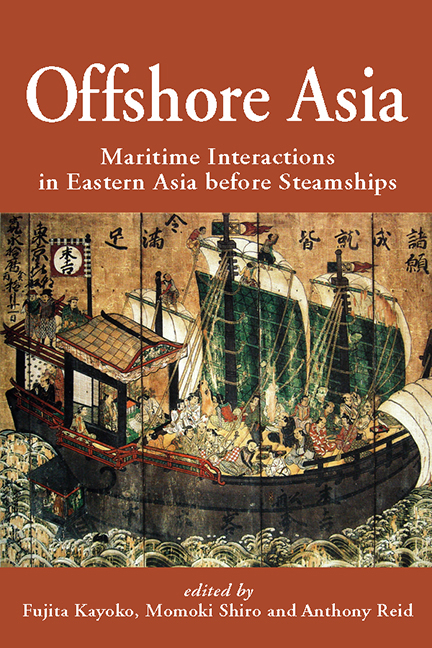Book contents
- Frontmatter
- Contents
- Maps
- Tables and Figures
- Preface
- Contributors
- Map 1 Eastern Asia in the 13th–16th Centuries
- 1 Introduction: Maritime Interactions in Eastern Asia
- 2 The Periodization of Southeast Asian History, in Comparison with that of Northeast Asia
- 3 Merchants, Envoys, Brokers and Pirates: Hokkien Connections in Pre-modern Maritime Asia
- 4 An Asian Commercial Ecumene, 900–1300 ce
- 5 The Japanese Archipelago and Maritime Asia from the 9th to the 14th Centuries
- 6 Saltpetre Trade and Warfare in Early Modern Asia
- 7 Shaping Maritime East Asia in the 15th and 16th Centuries through Choson Korea
- 8 Shipwreck Salvage and Survivors’ Repatriation Networks of the East Asian Rim in the Qing Dynasty
- 9 Wei Zhiyan and the Subversion of the Sakoku
- 10 Metal Exports and Textile Imports of Tokugawa Japan in the 17th Century: The South Asian Connection
- Bibliography of Works Cited
- Index
- NALANDA-SRIWIJAYA SERIES
5 - The Japanese Archipelago and Maritime Asia from the 9th to the 14th Centuries
Published online by Cambridge University Press: 21 October 2015
- Frontmatter
- Contents
- Maps
- Tables and Figures
- Preface
- Contributors
- Map 1 Eastern Asia in the 13th–16th Centuries
- 1 Introduction: Maritime Interactions in Eastern Asia
- 2 The Periodization of Southeast Asian History, in Comparison with that of Northeast Asia
- 3 Merchants, Envoys, Brokers and Pirates: Hokkien Connections in Pre-modern Maritime Asia
- 4 An Asian Commercial Ecumene, 900–1300 ce
- 5 The Japanese Archipelago and Maritime Asia from the 9th to the 14th Centuries
- 6 Saltpetre Trade and Warfare in Early Modern Asia
- 7 Shaping Maritime East Asia in the 15th and 16th Centuries through Choson Korea
- 8 Shipwreck Salvage and Survivors’ Repatriation Networks of the East Asian Rim in the Qing Dynasty
- 9 Wei Zhiyan and the Subversion of the Sakoku
- 10 Metal Exports and Textile Imports of Tokugawa Japan in the 17th Century: The South Asian Connection
- Bibliography of Works Cited
- Index
- NALANDA-SRIWIJAYA SERIES
Summary
This chapter examines the history of maritime exchange between the Japanese archipelago and various areas in Asia from the 9th to the first half of the 14th centuries. In contrast to the growth in pre-war research (which, of course, was closely related to Japanese expansion), post-war research after 1945 stagnated for some time. However, from the 1980s in particular, research in this field was gradually revitalized. Notably, scholars have now paid attention not only to the political and diplomatic interactions among states and rulers that were the main topics of traditional research, but have also actively focused on various levels of relationships among such peoples as maritime merchants, seafaring people, and monks. Consequently, a research direction became clear relating to various ways of considering the areas of “state” and “state borders”. Closely related to this point, many studies have been focusing on the Ryukyu Islands, the northern part of Tōhoku and Hokkaidō, areas which had been understood only as “peripheries” or “marginal areas” of “Japan (Yamato)” and had attracted less research interest. New studies have been trying to understand the historical evolution of these areas in their own terms in the context of their connection with a broader world outside the Japanese archipelago (“regional world” and “maritime world” across state borders).
Dividing the Japanese archipelago into three maritime areas, namely the west, the south, and the north, the first section of this chapter surveys the history of interactions between the Japanese archipelago and other Asian regions and the current status of research on this topic. As a concrete example illustrating the maritime linkage between the Japanese archipelago and other regions in Asia, the second section introduces the issue of Japanese sulphur export to China, a trade that has not attracted much attention.
DEVELOPMENTS IN THE WEST, THE SOUTH, AND THE NORTH OF THE JAPANESE ARCHIPELAGO AND THE MARITIME WORLD
The Western Maritime Region
The 9th Century as a Turning Point
In the 9th century, except for missions from Bohai, there was very little interaction between Japan and Asian countries through official state missions. On the other hand, private maritime merchants, described in the sources as “Silla merchants” and “Great Tang merchants”, often sailed to Kyūshū initiating private trade with Japan.
- Type
- Chapter
- Information
- Offshore AsiaMaritime Interactions in Eastern Asia before Steamships, pp. 112 - 129Publisher: ISEAS–Yusof Ishak InstitutePrint publication year: 2013

